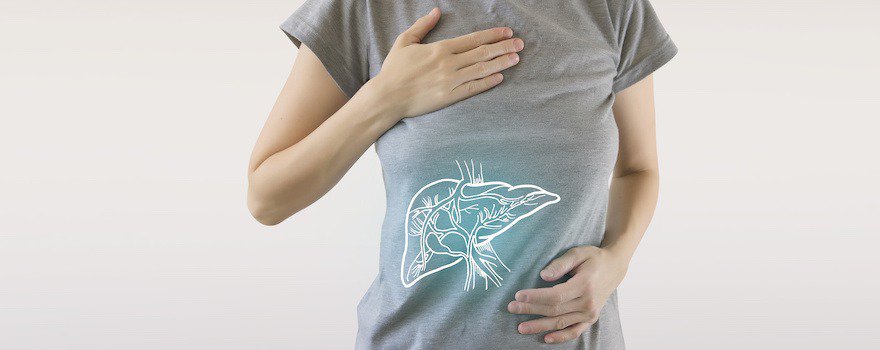Detox cures, are they worth it?
By detoxification, we mean any process, diets, or cures aimed at supporting the body’s elimination and purification functions.
These diets, mostly very “marketing-oriented,” claim to eliminate toxins from the body. Especially those present in our liver, with the goal of being in better shape, clarifying the complexion, or losing weight.
How? Thanks to monodiets, medicinal plants, commercial products, or even colon cleanses.
So, is detox useful or not? There are very few studies, but none have yet proven that a detox cure leads to better toxin elimination.
The “real” detoxification is naturally performed by our liver! It’s a long process that involves diet and lifestyle habits.
The liver, the detoxification organ
A true factory
The functions of the liver are multiple: storage and transformation of nutrients, breakdown of toxic substances, bile production, detoxification.
The liver thus plays a role in blood purification and waste elimination.
These can come from food, like additives and pesticides. But also from medications, or natural molecules produced during the digestion process, such as ammonia, which is highly toxic to the brain.
The liver possesses enzymes that allow the elimination of foreign substances from our body, via the gallbladder or the kidneys.
It does not store these toxins, but certain plants and nutrients are useful to support the liver’s work and contribute to digestive comfort.
What diet for liver health?
Think “hepato-protective” foods! Fruits and vegetables, especially artichokes, are beneficial.
Read also | 20 foods to protect and cleanse your liver
It’s important to provide enough nutrients and vitamins to the body while avoiding foods that cause digestive heaviness.
Focus on spices and aromatic herbs, rich in vitamins. I think of rosemary and turmeric.
Plant-based or lean proteins (chicken breast, white fish) should also be preferred.
On the other hand, limit saturated fats found in cold cuts, pastries, and processed foods.
To rest your liver, don’t drink alcohol, and replace coffee with tea or herbal teas. I recommend dandelion, desmodium, boldo, or linden.
Active compounds and plants to support the liver
Chlorella
Chlorella is known for its detoxifying action, thanks to its active compound, sporopollenin. This compound can bind to toxins to promote their elimination.
It is also studied for its support in people with non-alcoholic fatty liver disease (also known as “NASH”).
“NASH” or fatty liver disease, is a condition where fat accumulation in the liver is associated with an increase in liver enzymes.
This increase reflects liver distress due to inflammation that destroys liver cells.
In this study conducted over 8 weeks, chlorella allowed for a significant reduction in digestive enzymes and the weight of patients. Chlorella thus seems to play a protective role in maintaining liver health.
Artichoke
Artichoke is one of the oldest cultivated plants, already used in ancient Rome as an effective aid for digestion.
Its properties mainly stem from its choleretic effects: artichoke stimulates bile secretion by the liver, thus promoting digestion.
Its effects are multiple: artichoke is hepatoprotective because it increases the resistance of liver cells in case of inflammation. It also helps expel intestinal gas and soothes abdominal pain.
Finally, it is hypolipidemic. This means it reduces blood lipid levels, which is why it is found in many weight-loss diets.
This trial confirms the interest in using artichoke leaves as a liver protector in patients with non-alcoholic fatty liver disease.
Milk thistle
Milk thistle is a plant used in traditional medicine for over 2000 years, particularly in the treatment of jaundice.
Its seeds contain silymarin, a compound that promotes L-cysteine synthesis in the liver.
L-cysteine is an amino acid playing a central role in the body’s detoxification mechanism, especially for heavy metals, as explained by the Alternative Medicine Review.
Silymarin thus possesses powerful antioxidant properties, used in the treatment of liver disorders.
In this study conducted over 12 months, supplementation with silymarin reduced blood sugar levels (blood glucose) and insulin resistance in people suffering from diabetes and liver cirrhosis, thus improving liver function.
This other study conducted with 170 patients with cirrhosis treated with 140 mg of silymarin 3 times a day for 2 years, concluded with a significant improvement in the disease.
However, other results do not find a significant action on the improvement of liver function, and quality trials are necessary to conclude the effectiveness of milk thistle.
The advantage of this plant is the absence or few side effects even at high doses.
Black radish
The root of black radish is rich in fiber and a source of amino acids and vitamins. It also contains compounds called anthocyanins, which promote the drainage of the liver and gallbladder.
A study over 4 weeks examined the effect of black radish on the liver, in men who had taken paracetamol, eliminated by the liver. The black radish supplement had a positive influence on the detoxification of paracetamol, with a significant reduction in gamma-GT levels, a marker of liver diseases.
Glutathione
Glutathione is an antioxidant and detoxifying protein, found in food, and produced in our cells.
This molecule is particularly concentrated in the liver, where it plays a major role in detoxification. Glutathione participates in the elimination of pollutants, medicines, heavy metals, and pesticides.
How? Assisted by other molecules, it can attach to toxins to turn them into water-soluble compounds, thus making them easier to eliminate from the body through urine.
In a trial conducted with 29 patients with non-alcoholic fatty liver disease, taking 300 mg of glutathione for 3 months helped to reduce the amount of liver fat and fibrosis.
A reduction in levels of a liver enzyme, ALT, usually elevated when liver cells are damaged, was also observed.

In what form?
In capsules or tablets
Capsules can contain an active substance or plant powder.
The main advantage is that they are easy to manufacture, with a moderate cost, and convenient to take.
Capsules generally contain additives that help mask taste and odor.
However, the quality of capsules is variable: some additives may pose a problem, and dosing can vary greatly.
Tablets are made by compressing powders. It’s a dry product that has the advantage of being easy to preserve, and is just as convenient and reasonably priced compared to capsules.
The addition of preservatives and additives is sometimes necessary for their manufacture.
In fresh plant extract
Hydro-alcoholic maceration or mother tincture are two terms also used to refer to a fresh plant extract.
Fresh plants are placed in an alcohol solution and left to macerate, to reveal the active principles of the plant.
The final solution has a long shelf life and allows precise dosing and an adapted posology according to needs.
The presence of alcohol limits its use.
As an infusion
It is prepared with the fresh or dried parts of the medicinal plant. Easy to use, it also provides comfort and allows hydration.
Generally, they need to be taken several times a day to hope for a significant effect, and the sometimes strong taste can deter some.
In ampoules
The liquid form allows for good bioavailability of active ingredients, as they quickly pass into the body.
The ampoules are easy to swallow for people with swallowing difficulties. They are suitable for both children and the elderly, and the presence of additives is limited.
They often have a limited shelf life, and a more pronounced taste.
What criteria should be considered?
1. The forms
For plants, the qualities vary greatly. Choose bulk herbs for your infusions, particularly milk thistle, without added flavors.
Bulk is ecological, economical, and more concentrated in active ingredients.
When taking chlorella, artichoke, and black radish capsules, powder, or ampoules, opt for products with the shortest possible ingredient list.
Glutathione, on the other hand, is found in capsules or tablets in dietary supplements, either in an oxidized form (GSSG) or a reduced form (GSH).
The latter is preferred for better absorption. You should find the mention, or the abbreviation GSH on the box, to ensure it.
2. The mode of cultivation
Especially for plants: organic certification maximally ensures the absence of pesticides and the control of raw materials.
To verify that a product is indeed organic certified, you can check for the name of the certifying body on the Agence bio website.
Concerning chlorella: some come from Asia and are poorly traced. Chlorella having the ability to absorb heavy metals and pollutants, it is important to choose a product whose origin is mentioned.
Direct your choice towards a French culture, ensuring a non-polluted production source.
3. The combinations of active ingredients
The so-called “detox” infusions generally gather a mixture of plants for liver support and digestion. It is important to choose quality products, with a maximum of 5 plants per blend.
There are also many dietary supplements combining plants and active substances, notably interesting mixtures of milk thistle and glutathione.
Glutathione is sometimes combined with NAC (N-acetyl-cysteine), to aid its absorption in the body.
NAC is a particular form of L-cysteine, one of the three amino acids composing glutathione. This L-cysteine may be insufficient in the body, potentially hindering glutathione production.
4. The dosage
For artichoke, it depends on the form used. In capsules, it is found in leaf powder: at least 300 mg 3 times a day is advised for sufficient action.
There are also cynarine-standardized extracts, the most active molecule in artichoke. Here, a minimum dosage of 4% is required for optimal effect.
Finally, in hydro-alcoholic extract, take 50 to 100 drops per day of Cynara scolymus extract (the Latin name of artichoke), diluted in a drink of your choice, to be consumed before meals.
For milk thistle, rely on at least 210 mg of standardized milk thistle extract containing 70 – 80% silymarin per day.
For black radish, 15 ml of extract two to six times a day without exceeding 100 ml.
Chlorella is taken progressively to increase its tolerance in the body and avoid digestive issues.
It is recommended to consume between 3 and 4 g of chlorella in powder form per day, and up to 8 tablets for capsules dosed at 500 mg.
Finally, a minimum daily dose of 300 mg of glutathione is recommended to obtain sufficient action.
What are the precautions for use?
Artichoke, milk thistle and black radish are not recommended in cases of bile duct obstruction. They should not be used by pregnant and breastfeeding women.
Milk thistle is contraindicated in allergic individuals to Asteraceae (mugwort, chamomile, chrysanthemums). It may have a mild laxative effect which stops after a few days.
Finally, chlorella should be avoided in people with excess iron, those suffering from phenylketonuria or taking anticoagulant treatment.
To summarize
To ensure you choose high-quality detox / liver dietary supplements, check:
- The forms: choose bulk herbs for your infusions, especially milk thistle, or capsules for glutathione.
- Cultivation methods: particularly for plants, an organic certification.
- Combination of active ingredients: maximum of 5 plants in infusion, glutathione associated with NAC.
- Dosage: For example, for artichoke in capsule form, 300mg 3 times a day and in hydro-alcoholic extract form, 50 to 100 drops per day.
- Precautions for use: artichoke, milk thistle, and black radish are not recommended in cases of bile duct obstruction and should not be used by pregnant or breastfeeding women.



